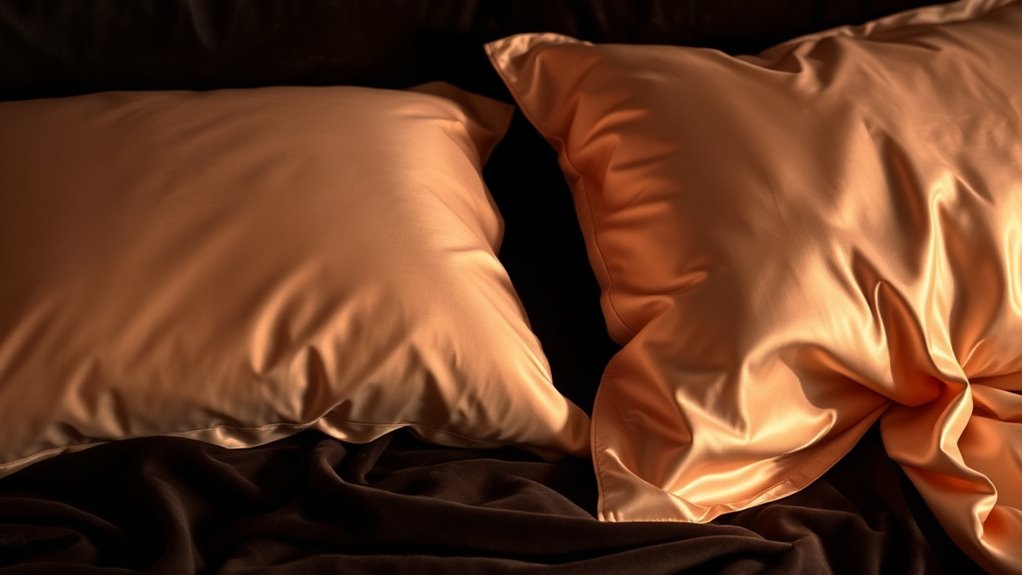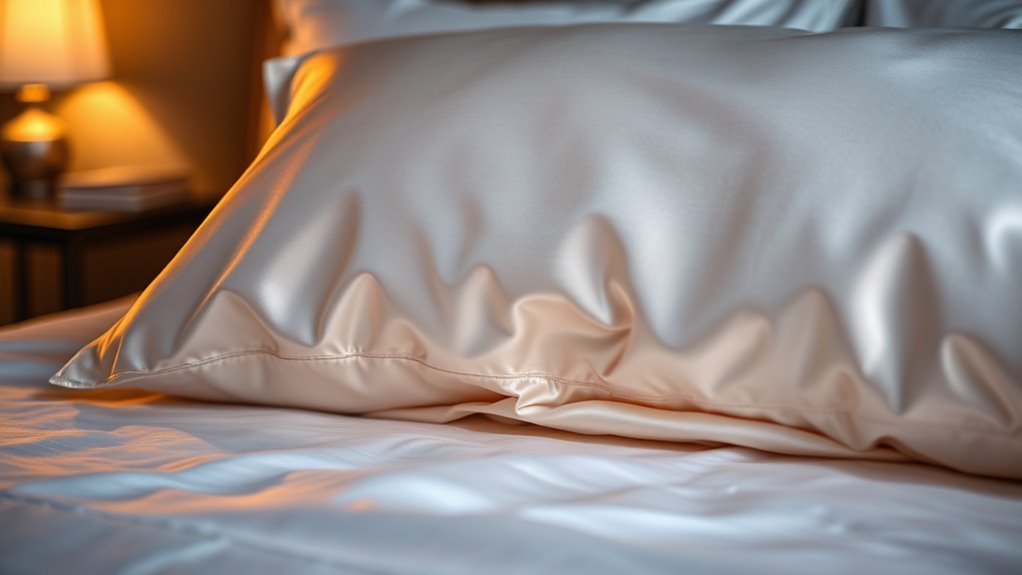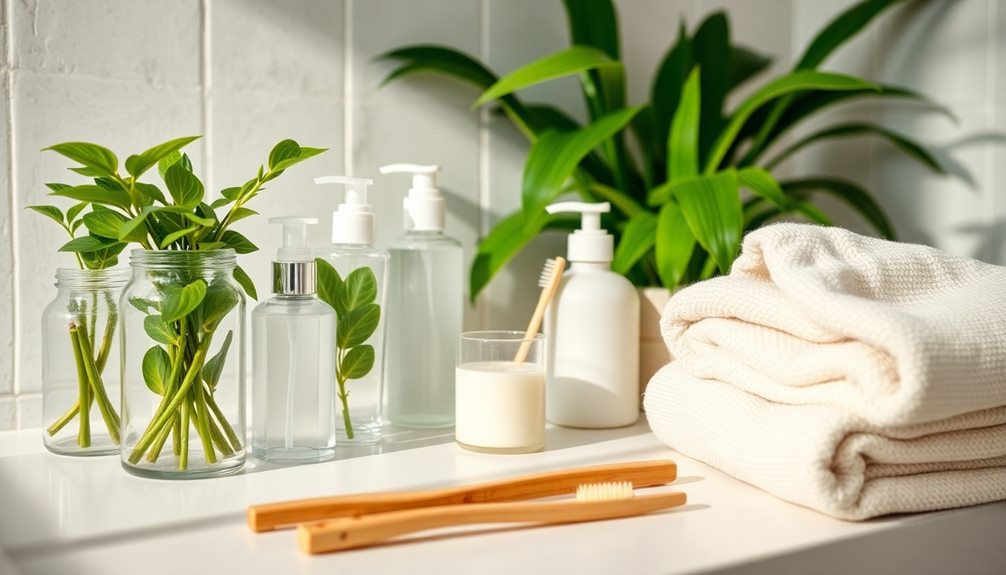Satin and silk both protect your hair overnight by reducing friction, preventing breakage and frizz. Silk feels luxurious and naturally smooth, promoting shine, but it’s delicate and needs gentle care. Satin, especially synthetic versions, is more durable, easier to wash, and more affordable, making it a practical choice. If you want to learn more about which option suits your lifestyle and hair, keep exploring the differences to find the best for you.
Key Takeaways
- Both silk and satin reduce hair friction during sleep, helping prevent breakage and frizz.
- Silk offers natural luster and gentle care but is more delicate and costly than satin.
- Satin, especially synthetic, is durable, easy to maintain, and a budget-friendly option for hair protection.
- Proper care is essential: silk needs gentle washing and storage, while satin is more resistant to frequent cleaning.
- Choose based on your budget, maintenance willingness, and preference for natural versus synthetic fibers for effective hair care.

When choosing between satin and silk, understanding their differences can help you make the right decision for your needs. Both materials are popular choices for nighttime hair care because they reduce friction, helping to prevent breakage and frizz. However, they differ markedly in fiber durability and cost, which can influence your choice. Silk, a natural fiber made from silkworm cocoons, tends to be more delicate. Its fibers are soft and smooth but can be prone to damage if not cared for properly. Silk’s delicate nature means it requires gentle handling and special care to maintain its luxurious qualities. Its fibers are also prone to damage from water, sunlight, and harsh detergents, so you need to wash it gently and store it properly. Satin, on the other hand, is a weave that can be made from various fibers, including polyester, nylon, or silk. When made from synthetic fibers like polyester, satin tends to be more durable because these fibers resist wear and tear better over time. This fiber durability makes satin a practical choice for those who want a long-lasting option or need something that can withstand frequent washing without losing its sheen or smoothness.
Satin, especially when synthetic, is more durable and easier to care for than delicate silk.
In terms of cost comparison, silk generally comes with a higher price tag. Genuine silk bedding or pillowcases can be quite an investment because of the labor-intensive process of harvesting and weaving the fibers. It’s prized for its natural luster and breathability, but those qualities come at a premium. Satin, especially when made from synthetic fibers, is usually much more affordable. You can find satin pillowcases and bedding at a fraction of the cost of silk, making it accessible for more people. While real silk offers luxurious feel and natural benefits, synthetic satin provides a budget-friendly alternative that still offers many of the same nighttime hair care benefits.
Your choice might also depend on how much maintenance you’re willing to do. Silk requires careful handling; it’s sensitive to water, sunlight, and harsh detergents, so you need to wash it gently and store it properly. Satin, especially if it’s made from polyester or nylon, is generally more durable and easier to care for. It can withstand more frequent washing and is less prone to wrinkling or damage, making it a convenient option if you prefer low-maintenance bedding.
Ultimately, your decision comes down to balancing fiber durability and cost. If you’re seeking a natural, luxurious experience and don’t mind the higher price and delicate care, silk is the way to go. But if you want a durable, budget-friendly option that still protects your hair and feels smooth against your skin, satin is an excellent choice. Both materials can help improve your nighttime hair health, so consider your priorities and choose what fits your lifestyle best.
Frequently Asked Questions
Are Satin and Silk Pillowcases Suitable for All Hair Types?
Yes, satin and silk pillowcases suit most hair types, but fiber compatibility varies. If you have sensitive skin or allergies, check for hypoallergenic options to avoid irritation. Fine, curly, or damaged hair benefits from these smooth fabrics because they reduce friction and breakage. However, if you have allergies to certain fibers, like silk or synthetic satin, opt for certified hypoallergenic versions. Always consider your unique needs for the best nighttime hair care.
How Do Satin and Silk Affect Hair Frizz Overnight?
Getting ahead of the frizz means choosing the right pillowcase. Satin and silk help by reducing fiber slickness, which prevents hair from snagging and frizzing overnight. They also boost moisture retention, keeping your hair hydrated and smooth by the morning. When you switch to these luxurious fabrics, you’ll notice less frizz and more sleekness—proving that sometimes, a simple change can work like a charm to tame unruly hair.
Can Satin or Silk Pillowcases Help Prevent Hair Breakage?
Yes, satin and silk pillowcases can help prevent hair breakage. They reduce friction, which minimizes hair snagging and breakage overnight. Plus, they promote moisture retention, keeping your hair hydrated and healthy. These materials also support scalp health by reducing irritation and dryness. Switching to satin or silk pillowcases is a simple, effective way to protect your hair while you sleep, leading to stronger, smoother hair over time.
Are There Any Health Benefits of Using Satin or Silk Bedding?
Using satin or silk bedding offers health benefits like hypoallergenic properties, reducing allergy symptoms and skin irritation. You also enjoy temperature regulation benefits, helping you stay cooler in summer and warmer in winter. These materials are gentle on your skin and hair, minimizing breakouts and dryness. By choosing satin or silk, you create a luxurious, comfortable sleep environment that promotes better overall health and well-being.
How Do I Properly Care for Satin and Silk Pillowcases?
Imagine your pillowcases as tender protectors of your hair—treat them with care. To properly care for satin and silk pillowcases, always follow proper washing techniques: hand wash or use a gentle cycle with cold water, and avoid harsh detergents. Air dry or use low heat, and store them in a cool, dry place. Regular pillowcase maintenance keeps them soft, shiny, and effective in protecting your hair and skin.
Conclusion
Choosing between satin and silk isn’t just about fabric—it’s about protecting your beauty sleep and waking up with hair that feels like a gentle whisper of luxury. As you lay your head down each night, remember that your pillowcase is your secret weapon in the battle against damage and breakage. Whether satin or silk, trust that your nighttime routine can be a tender act of self-love, turning every morning into a fresh start—because your hair deserves nothing less.










